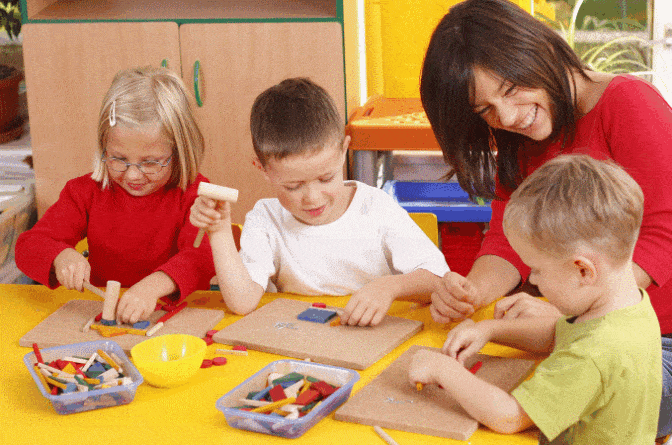
Before moving to America, many people wonder questions: how will I go with my children, how will they study there? It's time to find out how the American education system works. Have you ever wondered what makes it different from other educational systems in the world? In this article, we will take you on a journey through the American education system, revealing all the information you need.
The intricacies of the US school system
If you are a parent or just want to learn about the various education systems, this information is for you.
Preschool Education in the States 
Preschool education is the first level of education for children from birth to five years of age. It includes educational activities and games that build basic skills and prepare the child for elementary school.
Little children in America don't go to public kindergartens; they simply don't exist here. Instead, they can attend private ones, spend time at home with their parents or a nanny. Education in the US begins with grade zero, which is called "kindergarten" (kindergarten), and not from the first grade. At the age of 3 to 4, children attend preschool, and from the age of 5 they go to kindergarten or kindergarten.
Preschool education in the United States includes a wide range of activities and methods aimed at developing children from birth until about 5 or 6 years of age. It is focused on ensuring the comprehensive development of the child and preparing him for successful adaptation in primary school.
Preschool programs promote the development of social skills, including the ability to interact with other children and adults, resolve conflicts, cooperate and develop empathy. Children are given the opportunity to understand and manage their emotions, develop a sense of self-esteem, confidence and a positive attitude towards themselves.
Programs stimulate the intellectual development of children, including the development of creative thinking, logical thinking, problem-solving abilities and the development of basic skills in reading, writing and mathematics. Children are given the opportunity to develop motor skills, coordination and general physical activity through games, sports and exercise.
Programs contribute to the development of language skills, including the development of vocabulary, grammatical structure, listening and speaking skills. Preschool education actively uses the game as the main way of learning. Children role-play, build, draw, create and experiment to encourage creativity and imagination.
Children are given opportunities to explore the world through their senses – sight, sound, smell, touch and taste. An important goal of preschool education is to prepare children for school, including familiarization with basic concepts, reading, writing and math skills, as well as developing skills for independence and concentration.
Schools and preschools actively involve parents in the educational process, providing them with information about the progress of the child and cooperating with them in ensuring optimal conditions for development. Recognizing the diversity of children's needs and abilities, preschool programs seek to create individualized learning approaches that take into account the characteristics of each child.
The overall goal of preschool education in the United States is to prepare children for successful transition to elementary school and ensure their comprehensive growth and development in important aspects of their lives.
Primary education in the USA 
Elementary school, also known as elementary school, provides education for children aged 6 to 11. At this level, children learn core subjects such as reading, math, science, and social studies. They can also choose several elective subjects to develop their interests.
Classes in elementary school are divided into different learning zones. Students can work at round tables in groups of 5-6 people, on a carpet near shelves with books or at computers, of which there are usually several in the classroom. The teacher gives tasks, and the children work on them on their own. At the same time, they are allowed to move freely around the class.
In the middle classes of American schools, each subject has its own teacher, and students are given a certain freedom in choosing subjects. Mathematics, English, natural sciences (physics, chemistry, biology, geology, astronomy), history, physical education and creative activities remain compulsory subjects. Students also have the opportunity to choose 1-2 additional subjects on their own, most often they are computer technology, cooking, a foreign language or art.
By the way, in America individualism is greatly encouraged: children always sit on single desks. But, at the same time, they put a lot of emphasis on teamwork: constant group assignments, joint extracurricular projects and meetings. And here there is something that is fundamentally different from the system of education we are used to: here they are not based on clear facts, as we did: the chronology of history, sequence, only this way and nothing else. They guide students to reach the truth themselves, make their own creative decisions and create something radically new without any clear emphasis on the old.
And the concept "classmates" in American schools is not the same as in Russia. You can be in the same class as biology classmates, and at the same time study math with completely different classmates. In addition, students are given the opportunity to choose a more difficult program in a particular subject, for which they need to get an excellent annual grade.
High School in America 
In the upper grades of the American school, students have a lot of freedom in choosing subjects. Required — mathematics (2 years), English (4 years), science (2 years with laboratory work), social studies (3 years), physical education (1 year) and art course (1 year).
By the way, in American schools they do not overwhelm with homework, as they used to do in Russian. Here in the school schedule there is a built-in hour when students can devote their time to this, and after school it takes them about an hour or an hour and a half to do what is left. Convenient!
Starting in grade 9, students can choose subjects through the Advanced Placement (AP) program. There are about 38 additional sciences to choose from in 5 areas: industrial, agricultural, commercial, general and academic.
Assessment system and knowledge testing in the USA
And the most interesting thing is the grading system in American schools: A (excellent, excellent), B (good, good), C (satisfactory), D (poor), F (unsatisfactory, fail). At the same time, you probably saw in the films how the teacher distributes work specifically to each student. The thing is that in America it is not customary, as we do, to announce the results of the test to the whole class.
Each grade is confidential information for a particular student and his parents. And competitions between students of this kind are not held there. Relevant, perhaps, only for small towns.
Testing and assessment in US schools is essential for determining student achievement, evaluating the effectiveness of educational programs, and providing quality education. The testing system may vary from state to state and from school to school, but there are general principles. The United States uses a variety of test types and assessment methods, including:
- Standardized Tests: These tests have common standards across the country and allow comparison of student performance across states. Examples of such tests are SAT (Scholastic Assessment Test) and ACT (American College Testing), which are often used for admission to colleges and universities.
- State Tests: Each state may have its own state tests designed to meet the educational standards of that state. These tests assess knowledge and skills in various subjects and levels of education.
- Formative assessments: This is an assessment that takes place throughout the school year and aims to monitor the progress of students. This may include classwork, projects, oral responses, and other forms of activity.
- Summative assessments: This is an assessment conducted at the end of a school period or year to determine the level of knowledge and progress of students. These may include final exams, assignments, and tests.
- Portfolio: Some schools use a portfolio assessment method in which a student collects their work, projects, and achievements to showcase their learning and development.
- Teacher Assessment: Teachers can also evaluate student learning in class and in the classroom. This may include oral responses, tests, discussions, and other forms of interaction.
It is important to note that testing and assessment approaches may vary depending on the level of education (elementary, middle, high school ) and local education policies. In general, the purpose of knowledge assessment is not only to evaluate, but also to provide information about the level of learning in order to adapt teaching methods and support the development of each student.
Did you like the article? Share it with your friends on social networks and don't miss even more information on our website!